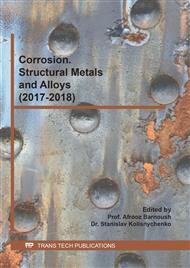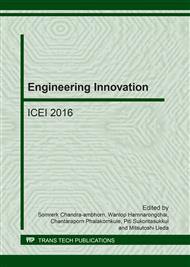p.96
p.105
p.111
p.117
p.123
p.129
p.137
p.143
p.149
Crevice Corrosion of Duplex Stainless Steels by Cyclic Potentiodynamic Polarization and Potentiostatic Techniques
Abstract:
Crevice corrosions of duplex stainless steels were investigated under the aggressive condition of sea water pumps in offshore petroleum platforms. The study aims to compare crevice corrosion behavior of three grades of duplex stainless steels, UNS S32101 (2101), UNS S31803 (2205) and UNS S32750, in seawater with 200 ppm of hypochlorite. Duplex steels were compared with a widely used austenitic steel UNS S31603 (316). Specimens were tested under synthetic sea water prepared at pH4, pH6 and pH8 by the cyclic potentiodynamics polarization technique and the potentiostatic technique. The results show that the duplex stainless steels had higher corrosion resistance compared with the 316. The released charges and the corrosion rates of the 2101 and the 2205 were similar, but much lower than those of the 2507especially after 3 months period.
Info:
Periodical:
Pages:
123-128
Citation:
Online since:
January 2017
Keywords:
Price:
Сopyright:
© 2017 Trans Tech Publications Ltd. All Rights Reserved
Share:
Citation:



